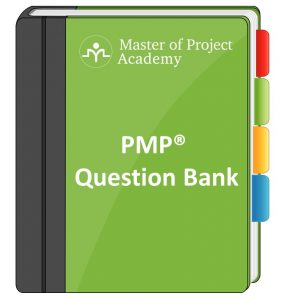PMP exam preparation needs a rigorous PMP study to pass the exam in your first attempt. One of the key factors that will affect your PMP success is practising with as many PMP exam questions as possible. The more you see and practice PMP example questions, the more you will see different possible PMP exam question formats. This will increase your chance to pass the exam in your first attempt.
We have prepared a 100% free and online 15 PMP exam questions for you to practice. We recommend you to go over the PMP example questions and write down your answers on a different sheet. After completing the PMP exam questions test, go through the rationales and answers at the end of this page. Go through your wrong answers for the PMP example questions and understand why you did it wrong.
Enhance your project management skills with Sandbox! Our exclusive membership includes monthly Office Hours sessions with Master Project Experts, offering an interactive learning experience to address all your project management and PMP Exam questions. In addition, Sandbox provides access to sample PMP and CAPM exams, helping you improve your exam-taking abilities.
After helping over 200,000 professionals in more than 180 countries with a 99.6% first attempt pass rate, we have prepared a seven step PMP study plan. Read this PMP study plan and create your own PMP prep NYC plan accordingly.
PMP Exam Questions #1
The primary purpose of Project Management Plan development is to—
a. Create a document to guide project execution and control
b. Document project assumptions and constraints
c. Promote communication among stakeholders
d. Define key project reports
PMP Exam Questions #2
Jan started her project in February with a project staff of 15 people, besides herself, three of whom also served as project management team members. By June, four more people had begun working on the project. How many more people and communication channels were on her team in June?
a. There were three more people on her team and 190 additional communication channels.
b. There were four more people and 120 additional communication channels.
c. There were three more people on her team and 70 additional communication channels.
d. There were four additional people on the team and 70 more communication channels.
Attend our 100% Online & Self-Paced One-Hour Free PMP Training.
PMP Exam Questions #3
A 12 month project has a budget at complete of $100,000. At month eight, actual costs were $104,000. What is the project status?
a. In trouble, since more was spent than was budgeted
b. Doing okay so far, since less was spent than was budgeted
c. There is not enough information to determine the status
d. Over budget and behind schedule
PMP Exam Questions #4
Force Majeure is a term derived from insurance law meaning .
a. Superior or irresistible force, such as lightning, earthquakes, storms, or floods.
b. Any party to a contract can redress alleged illegalities through any U.S. District Court.
c. The buyer can seek damages from the seller due to major contract breaches.
d. The seller neglected to exercise due care in performance and is thus subject to a breach of contract action.
PMP Exam Questions #5
While reviewing the estimates from the functional managers assigned to your project you discover that one cost estimate is clearly higher than those submitted for previous projects. You should—
a. Reject the estimate and remove the functional manager from the project
b. Request the supporting details for the estimate to ensure it has been properly prepared.
c. Accept the estimate and plan to use the additional funding as a reserve.
d. Question each functional manager for information about this estimate.
Did you see PMP Certification Training of Master of Project Academy? This online PMP exam prep training option satisfies the 35 contact hours project management training prerequisite of PMP certification requirements. It covers more than 300 lectures, over 750 practice questions, downloadable handouts, supporting documents, cheat sheets and several other PMP prep materials.
PMP success stories of Master of Project Academy proves the quality of this PMP exam prep course. Don Wheeler is one of the several PMP success stories of Master of Project Academy. Don passed the PMP exam successfully with the PMP training from Master of Project Academy and he scored “Above Target” on all five domains of the PMP exam. This is the highest score where a PMP candidate can get from the PMP exam. You can read Don’s PMP success story.
PMP Exam Questions #6
The 80/20 rule, also known as the Pareto Principle, is best described by which one of the following statements?
a. 80% of the problems in quality can be ascribed to management and 20% to the employees.
b. 80% of the cost of a product or service is in 20 % of the materials or labor required.
c. Eighty percent of all causes lead to 20% of all problems.
d. Many problems, perhaps as high as 80% of all problems, are generated by or result in a comparatively small number of causes, perhaps 20%.
PMP Exam Questions #7
Herzberg’s theory of motivation holds that if motivators such as achievement, recognition, and responsibility are not present, employees will _.
a. Become disillusioned and look for other employment.
b. Lack motivation but still work well.
c. Lack motivation and become dissatisfied with their work.
d. Use the workplace as a means to extend their social life.
PMP Exam Questions #8
If a risk event has a 90 percent chance of occurring and the impact will be $10,000, what does $9,000 represent?
a. Risk value
b. Expected value
c. Real value
d. Contingency budget
Enroll in our PMP Exam Simulator to access over 1,600 PMP questions and answers. You can see the demo of the PMP exam simulator here: Free PMP Exam Simulator.
PMP Exam Questions #9
PERT is an estimating tool that—
a. Takes into consideration risk as an element of the estimate
b. Can only be used for estimating level of effort
c. Can only be used in the precedence diagram method.
d. Uses only historical estimates to calculate standard deviations
PMP Exam Questions #10
A WBS is a product-oriented “family tree” of project components. Each item in the WBS is generally assigned a unique identifier. These identifiers are known collectively as the .
a. Chart of Accounts.
b. Code of Accounts.
c. Work Package control numbers.
d. WBS ID numbers.
Enroll in our FREE PMP Overview training to learn more about PMP Certification, and how to apply for PMP step-by-step.
PMP Exam Questions #11
There are five levels of stakeholder engagement. What are they?
a. Unaware, Resistant, Neutral, Supportive, Influencing
b. Aware, Resistant, Neutral, Supportive, Leading
c. Unaware, Resistant, Neutral, Supportive, Leading
d. Aware, Resistant, Interested, Supportive, Leadinga
PMP Example Questions Answers & Rationales
PMP Exam Questions#1
Answer option a., “Create a document to guide a project through execution, monitoring, control and closure,”
PMP Exam Questions #2
Answer option d. The answer to this question is based on the Communication Channel calculation, which is: n(n – 1)/2, where n = the number of stakeholders, team members, etc. Answering this question correctly requires that you work through three steps: Step 1, calculate the number of channels Jan previously had on her team In January: 16(15)/2 =120; Step 2, calculate the number of channels after 4 more people were added to the team: 20(19)/2 = 190; and finally Step 3, subtract the previous number of channels (120) from the current number of channels (190): 190 – 120 = 70. In other words, “There were four additional people [in February, a total of 20 people] on the team and 70 more communication channels [the 190 channels currently on the team minus the 120 channels existing in February].
PMP Exam Questions #3
Answer a. “In trouble, since more money was spent than was budgeted.” BAC = 100,000; eight months into the (1 year) project you’ve spent $104,000 eliminates b as an answer. While the project may or may not be complete at 8 months, there is not enough information given to determine if we are or are not behind schedule. C is eliminated as we do have an understanding as to our cost budget.
PMP Exam Questions #4
Answer option a. As stated in the Slide Presentation: Force Majeure is “An act of God. An event that could not reasonably have been guarded against.” Answer option a., “Superior or irresistible force, such as lightning, earthquakes, storms, or floods,” is the option that best describes Force Majeure.
PMP Exam Questions #5
Answer option b. To “Reject the estimate and remove the functional manager from the project” (answer option a.) would be disrespectful of the manager, as would questioning “each functional manager for information about this estimate” (option d.). If you were to “Accept the estimate and plan to use the additional funding as a reserve” (option c.), you would be irresponsible. The only reasonable answer is “Request the supporting details for the estimate to ensure it has been properly prepared,” option b.
You might want to check our 100% FREE PMP Question Bank Post as well. See more PMP example questions and double your chance in passing PMP Exam!
PMP Exam Questions #6
Answer option d. The Pareto Principle (also known as the 80/20 Rule) is not mentioned in the PMBOK but has been a perennial favorite on the PMP Exam. The correct answer here is wordy but correct. In fewer words, the principle – that most (possibly 80%) of all problems are due to a few (as few as 20%) causes – is clearly stated in the Slide Presentation in the Plan Quality section. None of the other options come close to an accurate description of the principle.
PMP Exam Questions #7
Answer option c. Herzberg’s theory of motivation, which consists of Hygiene Factors and Motivators, says that employees need to be motivated by recognition, work content, and the opportunity for growth. The organization’s Hygiene Factors – such as policy administration, salary, supervision, working conditions (or lack thereof) – are important, they do not in themselves motivate employees.
PMP Exam Questions #8
Answer option b. This question requires that you calculate the Expected Monetary Value (EMV), which is: EMV = Probability x Impact. In the problem, “90 percent chance of occurring “is the Probability, while “impact will be $10,000” is obviously the impact. Therefore: EMV = 0.9 x $10,000
= $9,000, which is answer option b., the “Expected value.”
PMP Exam Questions #9
Answer option a. PERT “is a technique for estimating…when there is uncertainty with the individual activity estimates” – “uncertainty” meaning, of course, risk.
PMP Exam Questions #10
Answer option b. “The WBS is finalized by assigning each Work Package to a Control Account and establishing a unique identifier for that Work Package from a Code of Accounts.”
PMP Exam Questions #11
Answer option c. is the correct answer, as highlighted on the PMBOK.
You might want to check our Sample PMP Questions post as well.





